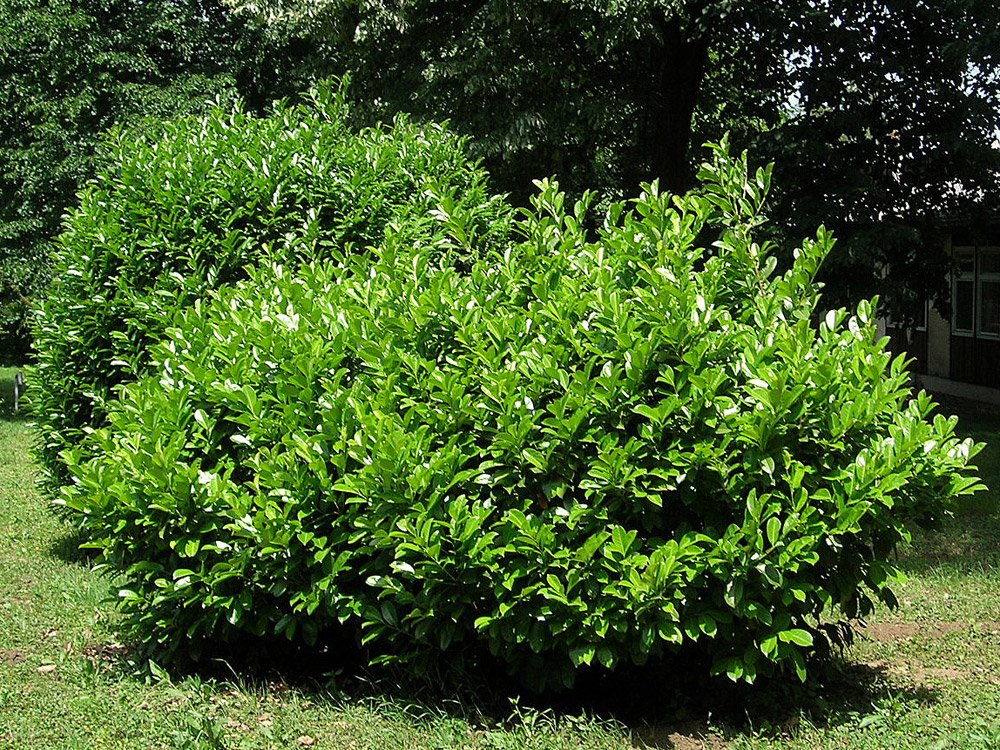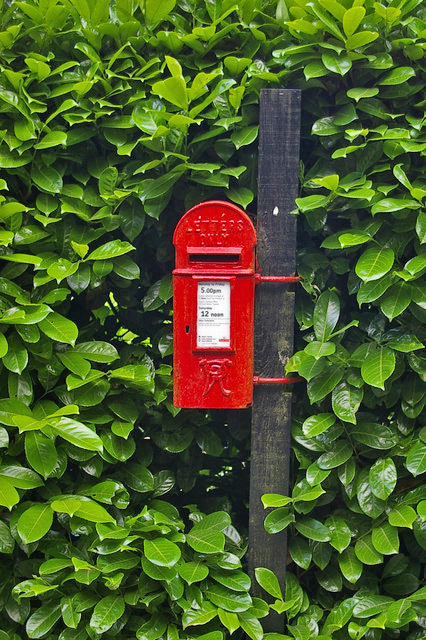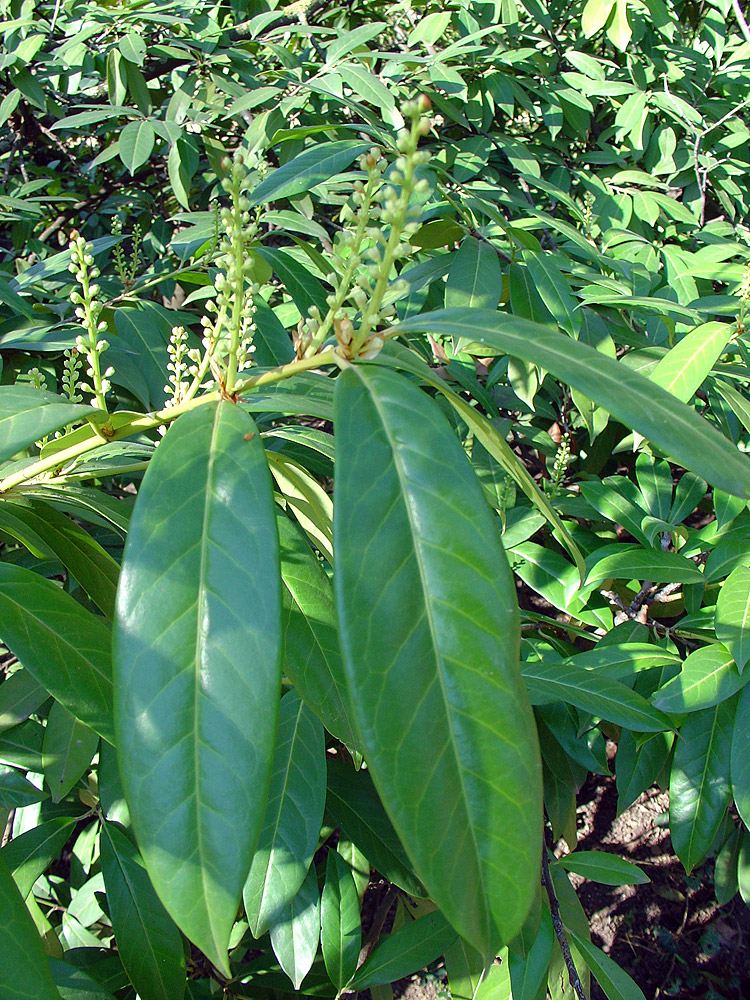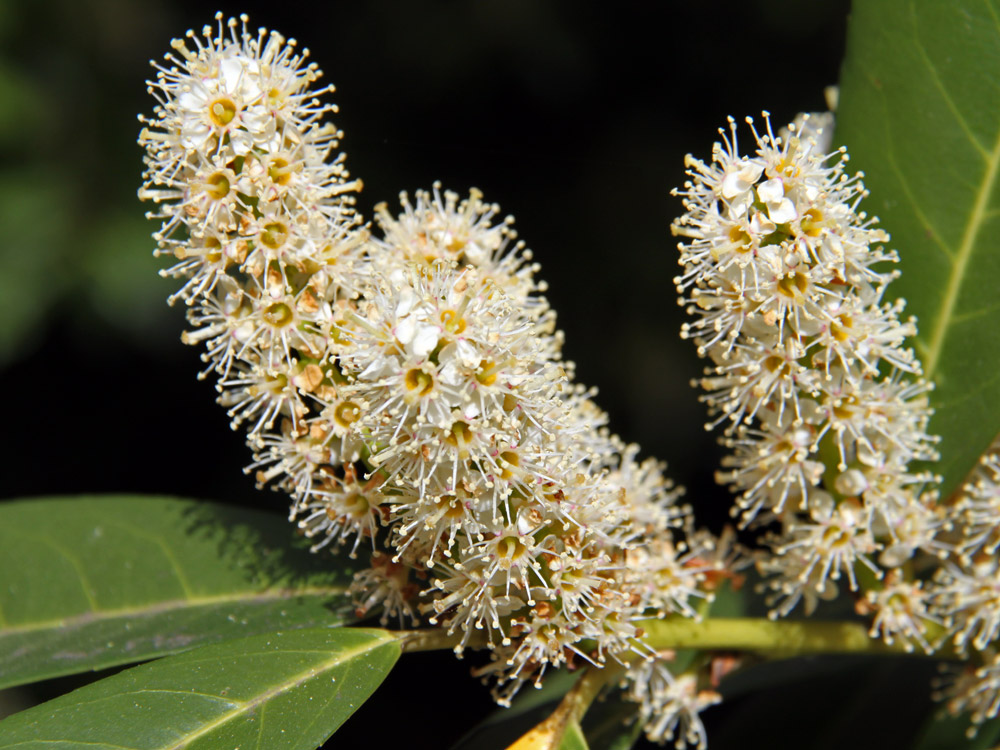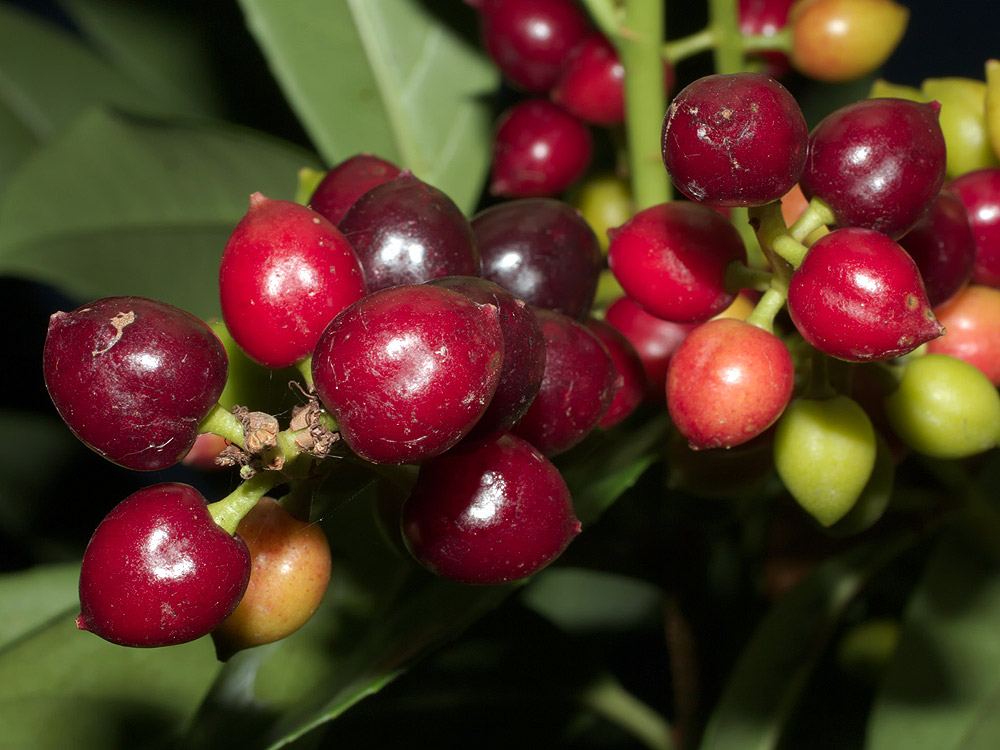Garden Plants, How
and where to grow them
Shrubs & Hedging
Cherry Laurel
Prunus laurocerasus - Shrub
A fast growing evergreen hedging plant that can be more readily kept in check than conifers that are often grown. Attractive glossy leaves and an ability to produce fresh shoots when cut back to brown wood make it a valuable garden plant.
Buy laurel, Prunus laurocerasus plants
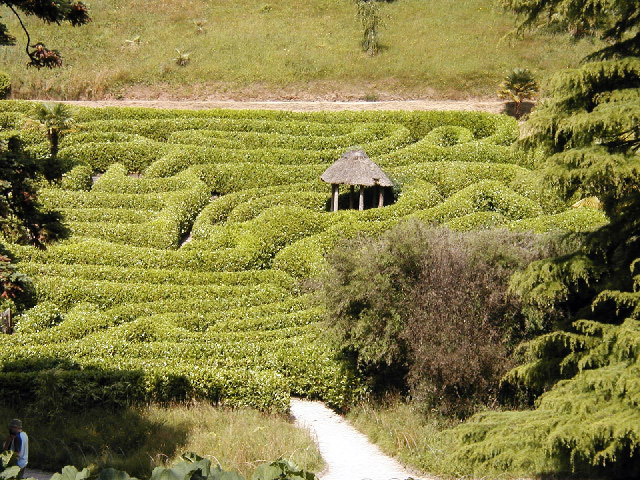 A much nicer looking plant, bushy, quick growing but
not in the same bully-boy league as Lleylandii, and
with the bonus of spring flowers and the ability to regenerate
itself when cut back hard into brown wood. An evergreen shrub
with large glossy, dark green leaves. It makes an excellent
hedging plant, and can cope with deep shade under trees as well
as full sun. Sometimes there are cherry red berries. Will grow
into a loose tree if allowed to go unpruned.
A much nicer looking plant, bushy, quick growing but
not in the same bully-boy league as Lleylandii, and
with the bonus of spring flowers and the ability to regenerate
itself when cut back hard into brown wood. An evergreen shrub
with large glossy, dark green leaves. It makes an excellent
hedging plant, and can cope with deep shade under trees as well
as full sun. Sometimes there are cherry red berries. Will grow
into a loose tree if allowed to go unpruned.
As well as being used for hedges, make a good windbreak for an exposed corner if planted alone, or a good dark green backdrop to more ornamental plants.
- Height and spread: 10m x 10m (30ft x 30ft) A smaller variety "Otto luyken" is available that grows only to about 1m x 1.5m (3ft x 5ft), good for the more restricted situation.
- Position: full sun, partial shade or shade
- Soil: any except shallow chalk
- Rate of growth: fast-growing
- Flowering period: April
- Flower colour: white
- Hardiness: fully hardy, not suitable for very exposed positions
- Uses: Specimen / Hedging / mixed border
- Planting distance when used for hedging: 60cm, 24"
- Clipped height: 1.2-2.5m, 4-8ft. can be larger
- Number of times to clip per season and when: 1, after flowering
- Pruning: Prune after flowering in May. Use secateurs rather than shears for pruning as the large leaves are easily cut through by shears and will go yellow and brown from the cut edge (not good).
- Responds to renovation?: Yes Responds well to renovation and drastic cutting back, stage this over 2 or 3 years if possible for a very large plant, but don't worry too much if you can't.
Questions about Prunus laurocerasus Cherry laurel
Most frequently asked question. I planted some laurels 4ft high 1 month ago, some leaves are wilting and going crusty. There are holes in the leaves though not all, and brown patches can you advise what to do as I don't want to lose them.
A. Laurels don't like being moved
much and the larger they are, the less they like it. Chances
are they're just having a sulk. Assuming you planted them
correctly it's a case of making sure they don't dry
out too much. Things will start happening in the next month
or so (April at time of writing) and it's more than likely
that the dropped leaves will be replaced by new buds that you
should see starting to grow? You also have to remember that
although laurels are evergreen this means they always have some
leaves rather than always have the same leaves, leaf drop is
part of the normal annual cycle. An upset (like transplanting)
means they might do it in one go. It's more a question of
hold your nerve for a while, make sure you "baby"
them through the first summer, a good soak once a week if it
turns out to be dry (not smaller daily waterings), mulch them
and feed in the autumn.
Q. I have a huge laurel tree in my back garden. It is about 30ft! It has just been knocked down by the storm winds and needs to be removed as is dangerous. Is it ok to burn the wood and leaves? It has been suggested to me that the fumes from burning the leaves is poisonous. Is this correct?
A. Poisonous - not really any more than usual bonfire fumes which are pretty bad anyway.
Laurel leaves are full of oil and ignite fiercely, which
is good in getting the fire going, but can be a bit surprising
if you're not expecting it. Start off with a smallish fire
and add extra branches to gauge how fast they will burn rather
than throwing loads on at once or it will burn like a minor
wildfire.
Q. I have a large west facing garden to the side of my Suffolk Cottage, bounding against a road. In April this year I planted a Laurel hedge along this boundary, I hope to eventually have a dense informal hedge around 6-8 feet high. The Laurels were 4ft high when planted and they have grown strongly over the summer, they are now around 5-6ft but are starting to look a little leggy. How do I go about cutting the hedge with the aim to achieve a dense high hedge? I very much hope you can help with this question as I have hunted high and low on the WW web and found very little advice.
A. If left to their own devices with
lots of space, laurels will grow into a bushy tree / tall shrub
about 20ft + high. It seems that this is what yours are in the
process of doing, particularly as you say they have grown strongly.
To get them to bush out, particularly low down, you need to
prune quite hard. Cut them back at the top to prevent the development
of a strong leader which will encourage a tree-like form. It's
difficult to guess without seeing them, but I'd take about
a foot off. Laurels respond well if rather slowly to being cut
back hard. If there are any branches low down, then cut them
back close to the trunk - even though this seems the wrong thing
to do. The plant will respond by breaking several buds where
there were originally only one or two, so helping cover up the
lower part of the stem. The best time to do this is late spring
after they have flowered, don't expect to see much coverage
for about a year, but it will come. If you're a bit unsure
about this drastic action, just do a couple in the middle of
the hedge (i.e. with one either side, and then the rest when
you're confident it works !). Prune laurels with secateurs
and loppers, hedge shears cut the large leaves causing die-off
at the leaf edge which looks a mess.
Q. I'd
really appreciate any info you might have re a dieback problem
I'm having with my laurel hedge. About 2 months ago
a three feet wide section of the hedge appeared frost-damaged
- we had 2 or 3 very sharp drops in temp at night during the
previous week. The hedge had been well cut back c3 years ago
due to building work but was flourishing with lots of lush new
growth - I thought its thinning perhaps had made it susceptible
to frost damage. This 3 feet section however has now extended
to almost 6 feet wide & appears to be spreading. My neighbour &
I are very concerned & would appreciate any advice on how
we might save it. The laurel is c.12 feet high/50 feet long &
I think was planted when the houses were built in 1920s - the
leaves are fine and small and a light green colour, not dark.
The dieback appears to start from the bottom up with leaves
wilting, then brown spots, then entire leaf brown and stems
browning. Is there a disease that affects laurel? or could the
roots be water-logged (nurseries here have been recently selling
off plants due to the extraordinary wet weather we have had!)
A friend has also suggested cats & their 'ablutions'
(another neighbour has two new cats).
A. If those cats can kill off a 12ft
high by 6ft wide 80 year old laurel, I'm glad they're
in Northern Ireland and not over here! Seriously though I think
we can disregard the cats as a factor. It's difficult to
tell without seeing the hedge directly. With such a large old
plant, I think the most likely cause will be a fungal disease
triggered by several factors that have acted together to weaken
the plant. Age, water logging, physical damage - letting fungal
spores in - may all have a part to play. The first thing I would
do would be to delve into the hedge and determine how many plants
the die-back is affecting, is it just one or is it moving to
others? Look carefully at the plants, leaves, stems, trunk for
any clues, I presume there aren't any pests or you'd
have mentioned them? Are there signs of fungal disease any where?
especially low down near the ground, is the bark damaged? Is
there anything peculiar about where the damaged plant/s are
growing? Are the branches the dead leaves are attached to dying
too? Snap one or two and see if there are signs of life. If
they are dead then cut back into a live part. If they are still
alive, things are looking better. To be honest things don't
sound too great and it may be a question of containment if the
problem can't be dealt with directly, stopping it from spreading
to the next plants on in the hedge. If the problem is containable
and stoppable then the good news is that laurels usually recover
well from some hard pruning.
Q. What is the best time to plant a laurel hedge?
A. The best time to plant any kind
of shrubs / trees / hedging is in the early autumn. September
to November. That way there's still enough of the growing
season left for the plants to get established before it gets
cold. It's not going to be so hot or dry that the plants
get stressed or need lots of looking after and come the spring
they're all ready and raring to go as they are established
already. The down side is that you don't really see much
growth for about 6 months. Spring, Feb to about May is also
good. If plants are containerised however they can be planted
at any time of the year as long as they're looked after,
but autumn is optimal.
Q. We have
a well established laurel hedge, either side of a huge Lleylandii
tree - the total hedge is 12ft high, 4ft thick and about 40
yards long. This year 10/15 yards have started to develop a
leaf curl with light brown (powdery) spots on the back of the
leaf. Would spraying with a bordeaux mixture cure this
disease? Any advice you can offer would be appreciated
A. It certainly sounds like a fungal disease, the rain of the past month has meant that fungi have found it easy to take hold on many plants. I'd get a proprietary fungicide and use that. You could use the Bordeaux mixture as well, but I wouldn't use it on its own. If the leaves fall, collect them and dispose down the tip - not on the compost heap, get them out of the garden. Spray the hedge as soon as you can and then repeat it 5-7 days later, you may need to do it again if the disease re-surfaces. Will it cure the disease? No guarantee, sometimes such diseases are a symptom of something else, like getting a sore throat with the flu - opportunists can make the most of a weakened condition. I would expect a good chance of recovery though.
Q. We have our garden enclosed by Laurel Hedges. Gradually one by one they are deteriorating i.e. leaves go yellow and brown and drop off. Why? on the stems one sees a 'Clear Gel' appearing to ease from the wood (the laurels are well established with 30mm diameter trunks). The gel appears along the lengths of the trunks and branches. Can you help please as holes are appearing everywhere and we are losing our lovely garden.
A. It sounds very much like your
laurels have a bacterial canker that particularly affects plants
of the Genus Prunus to which laurels belong. If there are clearly
defined areas of bark that are flattening and sinking inwards
near the regions of oozing sap, that just about confirms it.
Infected areas should be pruned out and burnt, though this should
only be done during the summer months if possible. Spray with
a copper based fungicide such as Bordeaux mixture or with copper
oxychloride. Ideally this should be done in late summer, then
early and mid autumn. Start now and leave about 2 weeks between
sprayings.
Q. Help with
rampant laurel greatly appreciated. We recently have moved and
are now occupying a property which includes a lovely, mature
garden. However, a few shrubs and trees are very over-grown.
I found your site by searching for laurel pruning, and whilst
I see you have already posted some advice on bringing into line
an eight foot laurel hedge, I hope you will advise me on how
to tackle one which has reached 25 to 30 feet in height and
12 feet in depth! The hedge runs along 60 or so feet of the
border between our property and our neighbour's and encroaches
on both. I have spoken to the chap next door who is as keen
as I to win back some room, but we both also agree that it would
be desirable to leave a screen between the two properties. Some
of the main trunks measure in excess of seven or eight inches
in diameter. The hedge is planted two feet away from a four
foot tall stone wall. How would you advise that I proceed?
A. Sounds like you've got a bit of a monster there! I'll start by admitting that I've never actually brought anything of that size down to a reasonable height and thickness, though I have tackled smaller, but still large Laurel hedges. Don't try to do anything until the late spring when it's growing strongly, pruning laurels in the dormant season can introduce disease and you might damage or eventually lose one or more plants. Laurels will generally grow very successfully from brown wood and so it is possible to get the result you want without too much of a problem, there will be a time where the screen is rather sparse and woody rather than thick and leafy however it will thicken up again.
As you're cutting so much off them, I'd try
to do it over more than one season. What you don't want
to do is say chop 3 feet off either side of a 12 foot thick
plant and then a further 2 feet the next year as all the energy
and regowth from the first cuts will be lost again. Cut one
side back fully and the other not all until it's recovered.
If it recovers well, you might even try the second side the
same season. I'd reduce height and one side to start with
and then the other side later on. Take care that you don't
let the bark tear off as larger branches or trunks fall, cut
through both sides partly before through the whole trunk. You'll
also be left with a huge pile of growth to get rid of. If you
have a mighty compost shredder and the patience, you could feed
it through that. If you have the space you could burn it, but
beware, laurel leaves are full of oils and burn like buggery!
You could take it to the skip if you have access to a van, or
you could pay someone else to dispose of it. If you choose to
pay someone else to do it, I'd be tempted to do the cutting
myself and get them to do the disposal as the kind of contractors
who do this tend not to be the most skilled or careful horticulturalists!
Oh yes, buy a new blade or two for your bow saw before you start
and use loppers where possible.
reply:
Hello Paul,
Many thanks for your reply. Your advice is
very welcome and timely. Lately, I have been approached by a
local contractor who, knowing that I wanted to drastically prune,
suggested that I should proceed with impunity, as 'you can
do pretty much what you want to laurel' and that we could
start immediately. I will now proceed with more caution and
confidence. Luckily for me, I sell bow saw blades!!! Thank you
once again.
Q. Nearly two years ago, I had a laurel hedge planted, it consists of about 30 plants and is now beautifully knitting and desperately in need of a bit of trimming. My question is, that many of the leaves are displaying holes, about the size of the top of a pencil. Could this be caterpillars, if not, what do you think it could be, and what would be a safe, preferably non-chemical way of treating it.
A. Sounds like a malady called "shot hole" are the hole edges clean and green - like they've just been eaten? or is there an inconspicuous but distinct brown ring at the edge of the hole? - if the ring is there it's probably shot hole. There will also be brown spots of dead tissue on the leaf. Patches of cells die and turn brown, then the brown dead part drops out leaving the hole. If it's caterpillars, you should be able to find some, possibly under the leaves if they're not conspicuous. Shot hole is a symptom rather than the name of a disease, and there are many possible causes from various kinds of fungi or bacteria. Treatment is by applying some kind of fungicide, copper or sulphur-based treatments are considered organic and you should be able to get a preparation at a garden centre (Bordeaux mixture contains copper).
Q. I have approx 1/3 of an acre at home idle. I have lots of laurel hedges grown in my garden as borders and have grown very fast. I had an idea of maybe buying approx 2 feet laurels and either potting or planting them on the 1/3 acre for a few years and selling on as a mature hedge. I think one of your answers says moving laurels especially as they get older is not a good idea. So could I pot them in lines for a few years until they are approx 5 or 6 feet and would this be a difficult process?
A. What you describe is perfectly possible, as a landscaper I have bought laurels in 10L pots that are about 4-5 feet high and they are very useful in giving a start to a hedge. If you go the container route, you need to think about how they are going to be watered, some degree of automation is needed even if it's turning on the tap for a sprinkler or leaky hose every now and then. You might also want to think about growing large ornamental conifers if you're doing this too, they were very useful to me as a landscaper and not easy to find. These can more easily be field grown and then sold in winter months root-balled with hessian. Make sure you do some research though locally as to the market, someone I know of grew half a a field of Lleylandii, by the time they were big enough to sell, no-one wanted to buy them thanks to the horror stories! laurels should be better though.
Buy laurel, Prunus laurocerasus plants
Photo credits: (numbering left to right top to bottom) 1-Bruce Hall - Creative Commons Attribution 3.0 Unported license. / 2-Gmihail at Serbian Wikipedia - Creative Commons Attribution 3.0 Unported license. / 3-Ian Capper - Creative Commons Attribution 3.0 Unported license. / 4-Mike Dodman - Creative Commons Attribution 3.0 Unported license. / 5-Retama - Creative Commons Attribution 3.0 Unported license. / 6-Slick - Creative Commons Attribution 1.0 license. universal / 7-Stanzilla - Creative Commons Attribution 3.0 Unported license.
Copyright 2000 - present. All Rights Reserved | Privacy Policy Statement

